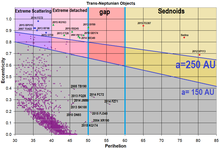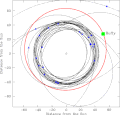|
(612911) 2004 XR190
(612911) 2004 XR190, informally nicknamed Buffy, is a trans-Neptunian object, classified as both a scattered disc object and a detached object, located in the outermost region of the Solar System. It was first observed on 11 December 2004, by astronomers with the Canada–France Ecliptic Plane Survey at the Mauna Kea Observatories, Hawaii, United States.[1][2] It is the largest known highly inclined (> 45°) object. With a perihelion of 51 AU, it belongs to a small and poorly understood group of very distant objects with moderate eccentricities.[10] Discovery and naming2004 XR190 was discovered on 11 December 2004.[1] It was discovered by astronomers led by (Rhiannon) Lynne Allen of the University of British Columbia as part of the Canada–France Ecliptic Plane Survey (CFEPS) using the Canada–France–Hawaii Telescope (CFHT) near the ecliptic. The team included Brett Gladman, John Kavelaars, Jean-Marc Petit, Joel Parker and Phil Nicholson.[2] In 2015, six precovery images from 2002 and 2003 were found in Sloan Digital Sky Survey data. The object was nicknamed "Buffy" by the discovery team, after the fictional vampire slayer Buffy Summers, and the team proposed several Inuit-based official names to the International Astronomical Union.[3] Orbit and classification 2004 XR190 orbits the Sun at a distance of 51.1–63.4 AU once every 433 years and 3 months (158,242 days; semi-major axis of 57.26 AU). Its orbit has a moderate eccentricity of 0.11 and a high inclination of 47° with respect to the ecliptic.[4] It belongs to the same group as 2014 FC72, 2014 FZ71, 2015 FJ345 and 2015 KQ174 (also see diagram), that are poorly understood for their large perihelia combined with moderate eccentricities. Considered a scattered and detached object,[5][6][7] 2004 XR190 is particularly unusual as it has an unusually circular orbit for a scattered-disc object (SDO). Although it is thought that traditional scattered-disc objects have been ejected into their current orbits by gravitational interactions with Neptune, the low eccentricity of its orbit and the distance of its perihelion (SDOs generally have highly eccentric orbits and perihelia less than 38 AU) seems hard to reconcile with such celestial mechanics. This has led to some uncertainty as to the current theoretical understanding of the outer Solar System. The theories include close stellar passages, unseen planet/rogue planets/planetary embryos in the early Kuiper belt, and resonance interaction with an outward-migrating Neptune. The Kozai mechanism is capable of transferring orbital eccentricity to a higher inclination.[10] The object is the largest object with an inclination larger than 45°,[15] traveling further "up and down" than "left to right" around the Sun when viewed edge-on along the ecliptic. Most distant objects2004 XR190 came to aphelion around 1901.[16] Other than long-period comets, it is currently about the thirteenth-most-distant known large body (57.5 AU) in the Solar System with a well-known orbit, after Eris and Dysnomia (96.3 AU), Gonggong (87.4 AU), Sedna (85.9 AU), 2014 FC69 (84.0 AU), 2006 QH181 (83.3 AU), 2012 VP113 (83.3 AU), 2013 FY27 (80.3 AU), 2010 GB174 (70.5 AU), 2000 CR105 (60.3 AU), 2003 QX113 (59.8 AU), and 2008 ST291 (59.6 AU).[3][17] Physical characteristicsWith assumed albedos between 0.04 and 0.25, and absolute magnitudes from 4.3 to 4.6, 2004 XR190 has an estimated diameter of 335 to 850 kilometers; the mean arrived at by considering the two single-figure estimates plus the centre points of the three ranges is 562 km, approximately a quarter the diameter of Pluto.[7][9][10][11][12][13] As of 2018, no well-documented spectral type and color indices, nor a rotational lightcurve have been obtained from spectroscopic and photometric observations; however, the Johnston's Archive lists a "taxonomic type" of "BR", and a "B-R magnitude" of 1.24.[7] The rotation period, pole and shape officially remain unknown. Gallery
See alsoNotesReferences
External linksWikimedia Commons has media related to (612911) 2004 XR190.
|
||||||||||||||||||||||||||||||||||||||||||||||||||||||||||||||




